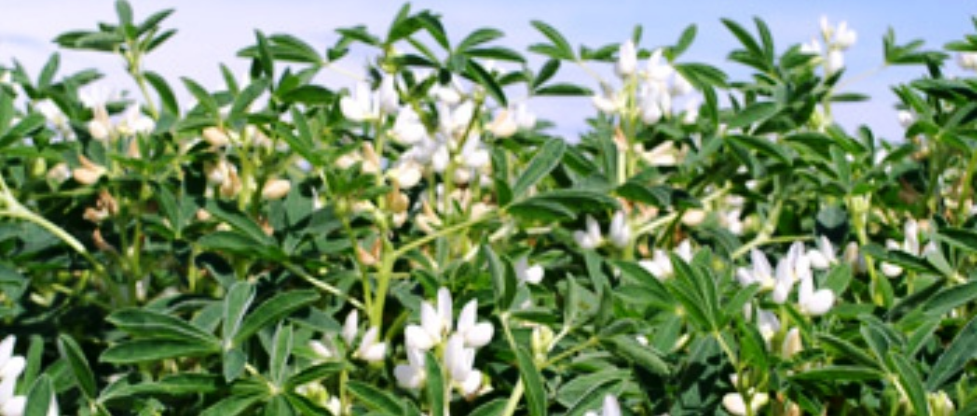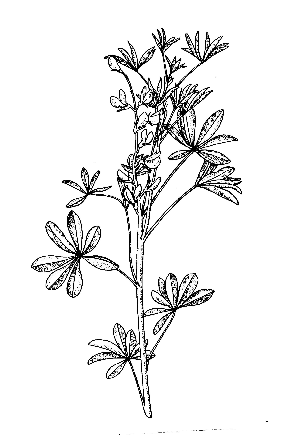Lupinus albus L. (White lupin)

L.albus L. 1753, Sp. Pl.:721; Willd. 1803, Sp.Pl. ed. 4, 3:1022; DC. 1825, Prodr. 2:407; Boiss. 1872, Fl. Or. 2:29; Willk. at Lange,1880, Prodr. Fl. Hisp.3:466; Halacsy, 1901, Consp. Fl. Graec. 1:341; Fiori, 1925, Nuov. Fl. Anal. Ital. 1:804; Zhukovsky, 1929, Bull.Appl. Bot. Gen. Pl-Breed., 21, 1:270, figs.13, 13a; Franco et Silva, 1968, in Fl. Europ. 2:105; Chamberlain in Davis, 1970, Fl. Turkey 3:38; Zohary, 1972, Fl. Palaest. 2:42; Gladstones, 1974, W. Austral. Dep. Agr. Techn. Bull. 26:5. – L. varius Gaertn. 1791, Fl. Fr. 2 : 324, tab.150, fig. 4, non L. 1753. – white lupin.
Typus: Herb. Linn. № 898 - 2 (LINN).

Lupinus albus L. (holotype).
It is an annual plant, more or less pubescent, 30 - 120 cm high. Stems and petioles are sparsely sericeous. Stipules are subulate, concrescent, with the petioles over 1/3 of their length. Leaflets (5–11) are oblong or obovate, glabrous above and villous below, with ciliate margins. Their size is 20–60 x 10–20 mm. Colour of the corolla is white, greyish or light blue, less frequently pink-blue, dark blue or violet-blue. Lower flowers of the inflorescence are alternate. The lower lip of the calyx is lobed with 3 teeth, the upper one is entire. Pods are 70–160 x 10–20 mm, 3 to 6- seeded; seeds are square, compressed, white with a variable tinge of salmon pink, or dotted, dark brown. 2n = 50.
The species is cultivated all over the Mediterranean and also in Egypt, Sudan, Ethiopia, Syria, Central and Western Europe, USA and South America, Tropical and Southern Africa, Russia, and Ukraine. The ancient culture of white lupin under the local name «hanchcoly» until recent times existed in Western Georgia (Kurlovich, 1996). It easily turns wild, especially in the Mediterranean. Lupinus albus L. has been selected as the type species of the genus Lupinus L.
This species’ closest neighbours described are L. graecus Boiss. et Sprun. and L. termis Forsk. The first one is a wild plant on the Balkan Peninsula; the second is grown in Egypt, Libya, Sudan, Ethiopia, Israel, Palestine and Syria. Information accumulated by scientists made it possible to revise and integrate the volumes of these species. All three species differ only in the colour and size of flowers and seeds (quantitative characters). Cultivated forms of white lupin were introduced in agricultural practice long time ago, before the ancient times, in the areas of the present-time Greece (Gladstones, 1974; Maissurjan and Atabiekova, 1974). From Greece they spread throughout the Mediterranean region and elsewhere. To the south (Egypt, Libya, Palestine) mainly the forms with white seeds and pink-and-blue or light pink flowers (L. termis) were spread, while westwards (Apennine Peninsula and farther) mostly the forms with white seeds and greyish-blue or white seeds (L. albus) dispersed. White lupin (L. albus) is still grown in Greece, where wild L. graecus is also widespread. The absence of distinct specific characters makes it possible to consider all three species as parts of a single species of Linnaeus (L. albus L). However, the existence of geographical and physiological differentiation is sufficient to recognize them as having the rank of subspecies within L. albus L: subsp. albus, subsp. graecus (Boiss. et Sprun.) Franco et Silva and subsp. termis (Forsk.) Ponert.
Smaller species such as L. vavilovii Atab. et Maiss. and L. jugoslavicus Kazim. et Nowacki, recognized by some plant growers of the ex-USSR and Poland, are only nomenclature synonyms of the Balkan subspecies graecus.
The scheme of classification of Lupinus albus L.
I. Subsp. graecus (Boiss. et Spun.) Franko et Silva
2. Subsp. termis (Forsk.) Ponert.
I. Var. abissinicus Libk.
2. Var. subroseus Libk.
3. Subsp. albus L.
3. Var. albus
4. Var.vavilovii (Atab.) Kurl. et Stankev.
5. Var vulgaris Libk.
I. f. libkindae Kurl. et Stankev.
Description of intraspecific taxa in Lupinus albus L.
Key to the subspecies of Lupinus albus L.
1. Rosettes are formed initially from the leaves; stalks appear at the time of flowering. The corolla is dark-blue with a white centro-basal spot at the base of the vexillum. Pods are 60–80 x 11–14 mm, shattering at maturity; seed are 7–10 x 6–8 x 2–3 mm, dark brown, dotted, with impermeable testa. Native to the Balkan Peninsula ………………1. Subsp. graecus
+ The rosette is lacking. The colour of the corolla is pink, blue, greyish, light blue or white. Pods are 80–150 x 16–20 mm in size, indehiscent at maturity; seed are pinkish-white or white with permeable testa ………………………………. 2.
2. Plants are shaggy, sericeous. The inflorescence is stretched, crumbly. Flowers are pink or blue. The calyx is with a bract. Occurs in Egypt, Libya, Sudan, Ethiopia and Israel ………..................………………………… 2. Subsp. termis
+ Plants are softly villous. The inflorescence is short, more or less compact. Flowers are greyish, light blue or white. The calyx is without bract (it falls quickly).
Cultivated in the Mediterranean, Europe, North and South America, Asia .. ........................…… 3. Subsp. albus
1. Subsp. graecus (Boiss. et Sprun.) Franco et Silva, 1968, Feddes Repert. 79 :52; idem, 1968, in Fl. Europ. 2 : 105; Chamberlain in Davis, 1970, Fl. Turk. 3 :39. - L.graecus Boiss. et Sprun. 1843, Diagn. pl. or. nov. 2:15; Halacsy, 1901, l. c.:341. - L.jugoslavicus Kasimierski et Nowacki, 1961, Gen. Polon. 2:115. - L.vavilovii Atab. et Maiss. 1962, Izw. TSXA, 44 (1):239. - L.albus var. graecus (Boiss. et Sprun.) Gladstones, 1974, l. c.: 7.
Typpus: In cultis Graeciae, inter Spartam et Mistra, E. Boisser et W. Spruner, April 1842 (G).
Two- to four-year plant in the nature and annual in culture. It is a direct wild ancestor of white lupin. This subspecies is spread in Greece, on Crete and other Aegean islands, in Albania and western Turkey (Gladstones, 1974) and can also be found in Italy (Hammer et al., 1992). It differs from other subspecies by having small diversity of forms.
2. Subsp. termis (Forsk.) Ponert, 1973, Feddes Rep. 83 (9 - 10) :619. - L. termis Forsk, 1775, Fl. Aegypt:131; Willd. 1803, l.c.:1023; Guss. 1828, Fl. Sic. Prodr. 2:397; Bertol. 1847, Fl. Ital. 7:411; Boiss. 1872, Fl. Or. 2:29; Post. 1896, Fl. Syr. Pal. Sin.:213; Halacsy, 1901, Fl. Graec. 1:341; Plitmann, 1966, Isr. Journ. Bot. 15:26. - L.albus var. termis (Forsk). Fiori, 1925; Nouv. Fl. Anal. Ital. 1:804; Hanelt, 1960, Lupinen 10, fig. 4, 12.
Typus : In Delta ad pagum Nedjel. Copiose in agris, an spontaneus, nescio ( C? ).
Subsp. termis differs from the standard subspecies (subsp. albus) by earlier flowering, finer stems and smaller flowers and seed. The flowers have a different colour. The name of this subspecies takes place from the Greek term «thermos». In the Mediterranean countries it is usually called «turmus» (or alternative versions).
Spread and cultivated in Egypt, Libya, Sudan, Ethiopia and Israel. Easily turns wild. We have at our disposal accessions from Libya. Egypt and Ethiopia. Libkind, 1931) described it as varietas but she did not indicate any types.
1. Var. abissinicus Libk. 1931, Lupin: 59, sine typo. - Flowers pink-and-blue. Vegetative parts with anthocyan.
Neotypus: `B -5`, received from Belarus, k-2237, reproduction of Pushkin`s laboratories of VIR, 28.07.1989, L.T. Kartuzova (WIR).
Distribution - the upper reaches of the Nile.
2. Var. subroseus Libk. 1931, l. c.: 59, sine typo. - Flowers light -pink. Vegetative parts green.
Neotypus: Libya, k-2094, reproduction of Pushkin`s laboratories of VIR, 28.08.1989, L.T. Kartuzova (WIR).
Distribution - Libya, Egypt, Israel, Syria.
3. Subsp. albus.
Distinctive features are thick meaty stalks, large leafs and seeds. The genepool of subsp. albus has wide variations in physiological properties of plants. Cultivated in many countries of Europe, Asia and America.
3. Var. albus Kurl. et Stankev. 1990, Bull. Appl. Bot. Gen. Pl.-Breed., Leningrad, 135:33. - Flowers white, carina`s edge without anthocyan.
We put the accession `Mutant 47` down to this varietas.
4. Var. vavilovii Kurl.et Stankev. 1990, l. c.:33. - Flowers white, carina`s edge with anthocyan.
Typus: `Bialy - 1`, Poland, k-1602, reproduction of Pushkin`s laboratories of VIR, 9.08.1986, A.K. Stankevich (WIR).
5. Var. vulgaris Libk. 1931, l. c.: 59, sine typo. - Flowers grayish-blue, carina`s edge with anthocyan.
Neotypes: `Kievsky mutant`, Ukraine, k-1904, reproduction of Pushkin`s laboratories of VIR, 9.08.1989, B.S. Kurlovich (WIR).
This varietas is the most spread.
1. f. libkindae Kurl. et Stankev. 1990, l. c.:33. - Side shoots absent or shortened. Flowers axillary.
Typus: `EP-1`, Poland, k-2890, reproduction of Pushkin`s laboratories of VIR, 24.08.1989, B.S. Kurlovich (WIR).



















